Personage that appear in the communities of Pujilí and Saquisilí and others of the province of Cotopaxi, mainly in Corpus Cristi’s festivities and of the Sacred Kings, mix with the old celebrations of the solstice and Inti Raymi or Sacred Party of the Sun.
Danzante, is the heir of the Tushug-Cayapa, priest maker of the rain, Mister of the land, who formerly behaved in his rich gear, the sacred symbols of the fecundity, of the sun and the moon, those that as a consequence of the indiscriminate exploitation to the native people, little by little have gone changing, first for currencies of gold and silver and at the present time, for mirrors, religious images, animal representations of mud and plastic, as well as showy decorations of false jewels. The dance of the dancers, in corners and compass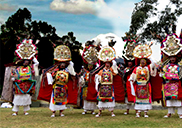 of 2 x 4 is leading by the prioste or «mayor” chosen for one year, with great ritual expression; in order for their rhythmic and solemn movements. The mask, the bell and the multicolored tape, supplement the ceremonious meaning of the dance.
of 2 x 4 is leading by the prioste or «mayor” chosen for one year, with great ritual expression; in order for their rhythmic and solemn movements. The mask, the bell and the multicolored tape, supplement the ceremonious meaning of the dance.
Chigualos manabitas. – Derived custom of the living room games like “la pájara pinta”, “the house of love”, “the fleuron”, “the marvel flower” and in a particular way “the little hat”. The chigualos, luck of cooing and carols that are sung in angelito funeral wakes or in the Jesus boy’s celebrations in the rural communities of Manabí and Esmeraldas.
Procession, christmas, profane verses, hoods and infantile celebration , precede to the “ dances of the iguana” and they will culminate with a mature habit of exquisite montubio flavor , the dance of the “Butterfly and the Colorao”, alive expression of love, illusion and disappointment.
Located in the valley of the Chota, cheerful and riotous, settles the afroecuadorian culture of the mountain province of Imbabura, cradle of the Banda Mocha and this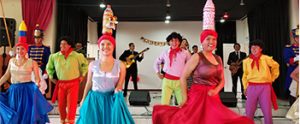 in turn mother of the bomb, hot rhythm; ovos´s land and of the skillful dance of the bottle, right now presented with delicate touch of respectful cartoon.
in turn mother of the bomb, hot rhythm; ovos´s land and of the skillful dance of the bottle, right now presented with delicate touch of respectful cartoon.
Happy tradition of the towns that make up the Ecuadorian coast.
The settlement of the royal armies in the times of Grancolombia and the golden age of export of national products in the nascent republic gave way to the mixture of social customs, rhythms and Euro-Ecuadorian expressions.
of Grancolombia and the golden age of export of national products in the nascent republic gave way to the mixture of social customs, rhythms and Euro-Ecuadorian expressions.
The harvesting of rice, coffee, cocoa, the  montubios market and rodeo and the cheerful machetero dance in the heat of the amorfino picaresque, is still characteristic of the people of our tropical zone.
montubios market and rodeo and the cheerful machetero dance in the heat of the amorfino picaresque, is still characteristic of the people of our tropical zone.
Born, care, preparation and tissue in Montecristi, province of Manabi, the straw hats, to the satisfaction of Ecuador, was declared  by UNESCO «intangible heritage of humanity».
by UNESCO «intangible heritage of humanity».
The fineness of the fabric, its versatile elegance and delicate texture finish, has astonished kings and presidents who have personally used, considering it as an article of distinction and class.
The straw hats is proudly Ecuadorian skilled weavers of Manabi and Azuay it processed and marketed around the world.
But this hat, also has a history of personal interaction Rooting our Ecuadorian identity. 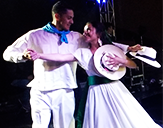 The guayaquileño poet, Paco del Castillo, probably in love with a weaver of hats, wrote a poem, the musician Philemon Macias manabita composed the music in the rhythm of coastal pasillo, Los Reales sang and the Ballet de Ecuador de Luis Beltran choreographed and masterfully dances this… ROMANCE TO MANABITA WEAVER.
The guayaquileño poet, Paco del Castillo, probably in love with a weaver of hats, wrote a poem, the musician Philemon Macias manabita composed the music in the rhythm of coastal pasillo, Los Reales sang and the Ballet de Ecuador de Luis Beltran choreographed and masterfully dances this… ROMANCE TO MANABITA WEAVER.
Amazonia, mysterious and deep jungle, warm and generous; with mythical secrets and a delicate balance of the nature, 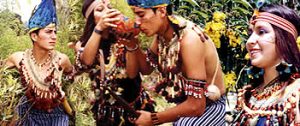 Dances like of the Japa, Jempe and the cheerful songs Tzukanka apa nuya uchi and séécha nuwa, exalt to the deer, to the toucan, to the man and the forest, to the blue bird or hummingbird transformed into beautiful woman to which it is necessary to fall in love with the best braveries.
Dances like of the Japa, Jempe and the cheerful songs Tzukanka apa nuya uchi and séécha nuwa, exalt to the deer, to the toucan, to the man and the forest, to the blue bird or hummingbird transformed into beautiful woman to which it is necessary to fall in love with the best braveries.
The different evangelizing currents arrivals to territories of Amerindian during the European occupation to conquest title, and the culture of adoring to many deities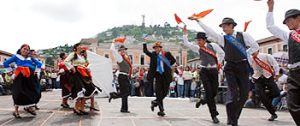 in our aboriginal people, it was producing religious mix in the subjected towns that little by little have left rooting in people like a devotion luck, prayer and gratefulness. The enormous multiplicity of religious parties that by the moment prevails in our territory, Party of Sacred Kings, of Corpus Cristi, Lent, Sant Week , Christmas, etc., that the devote ones with respect and solemnity take place, inclusive with pagan representations and offerings that look for the divine grace to their effort.
in our aboriginal people, it was producing religious mix in the subjected towns that little by little have left rooting in people like a devotion luck, prayer and gratefulness. The enormous multiplicity of religious parties that by the moment prevails in our territory, Party of Sacred Kings, of Corpus Cristi, Lent, Sant Week , Christmas, etc., that the devote ones with respect and solemnity take place, inclusive with pagan representations and offerings that look for the divine grace to their effort.
Romeria, is one of these demonstrations of  faith and devotion that year to year is appreciated in the cross-breed of our people. Finished the mass of offerings, won’t lack the town band, the pyrotechnic fires, the priostes and those disguised to express the spiritual joy of the party.
faith and devotion that year to year is appreciated in the cross-breed of our people. Finished the mass of offerings, won’t lack the town band, the pyrotechnic fires, the priostes and those disguised to express the spiritual joy of the party.
Ceremonial dance, magic rite of intrinsic relationship of blood, land, rain and sun. The Coraza, personage of San Rafael’s community, 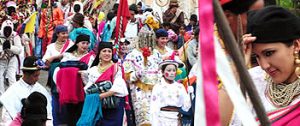 province of Imbabura, richly adorned and by the moment seen in San Luis Bishop’s festivities in the month of August, symbolizes the spirit of the agrarian divinity that should be revitalized through the sacred offering
province of Imbabura, richly adorned and by the moment seen in San Luis Bishop’s festivities in the month of August, symbolizes the spirit of the agrarian divinity that should be revitalized through the sacred offering
Ñaupadores, Captaincies, Ñustas, Loas and Yumbos to the pingullos rhythm, rondadores, flutes and drums, will accompany to the celebration 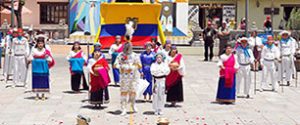 of this wonderful folkloric act, that was sought to disappear him for religious prohibition by their own spiritual magnitude. The Pendoneros, will sign the testimony of the ceremony.
of this wonderful folkloric act, that was sought to disappear him for religious prohibition by their own spiritual magnitude. The Pendoneros, will sign the testimony of the ceremony.
The origins of this festivity date from the first human establishments in Cochasqui and Puntyatzil, centers of primordial 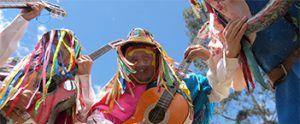 importance in the development of the Quitu-Cara culture, spiritual conjunction of the man’s relationship with the nature.
importance in the development of the Quitu-Cara culture, spiritual conjunction of the man’s relationship with the nature.
Sanjuanes, Saint Pedro and Saint Pablo and their octaves arrived in the communities of Mojanda, Cayambe, until Cotacachi and the land of the Caranqui of the provinces of Pichincha and Imbabura. bass drums, churos and cachos summon to the partialities from the area to the “taking of the square”, “delivery of branches” and “starts up of the rooster”. On June, month of the solstice, the crops glitter and Aya  Humas, Aruchicos, Chinucas and Guangudas; Clowns, Guasicanas and Carishinas, in hardened taquido expressions, go in huddle to the celebration of the Pacha Mama, the mother earth.
Humas, Aruchicos, Chinucas and Guangudas; Clowns, Guasicanas and Carishinas, in hardened taquido expressions, go in huddle to the celebration of the Pacha Mama, the mother earth.
The colony in our history, alone not was a process of imposition, exploitation and conflicts, the 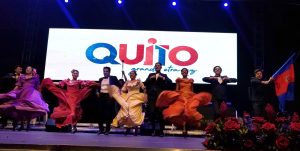 surprising domain of the fine arts, the incursion in the sciences, the creation of new musical rhythms and the coalition of races and social customs, they also left its print positive a figured miscegenation of romanticism and courtship that up to now is part of the daily life the coastal and mountain
surprising domain of the fine arts, the incursion in the sciences, the creation of new musical rhythms and the coalition of races and social customs, they also left its print positive a figured miscegenation of romanticism and courtship that up to now is part of the daily life the coastal and mountain
You come the dances then of living room the best braveries and the most refined attires that harmonize with 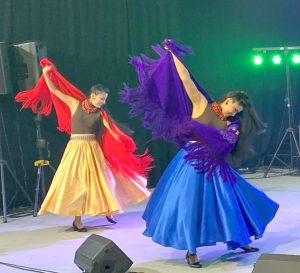 the elegance to shine and dexterity takes the new steps. Pasillos, pasacalles, albazos and cachullapi, among other, will get dressed of silk to reaffirm our cultural wealth; the serenades and songs to the compass of the guitars, acordeones and popular bands, they will also shine with having tuned voices and they will sing to the love, to the homeland and the life.
the elegance to shine and dexterity takes the new steps. Pasillos, pasacalles, albazos and cachullapi, among other, will get dressed of silk to reaffirm our cultural wealth; the serenades and songs to the compass of the guitars, acordeones and popular bands, they will also shine with having tuned voices and they will sing to the love, to the homeland and the life.
Bailes Mestizos
Our non alone ballet has centered its attention in the creation of choreographies that they speak of the national folklore and Latin American as part of our repertoire, we also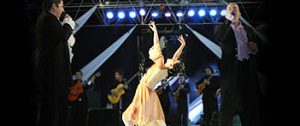 intrude in the contemporary dance with outstanding dancers formed for it; this way, the foreign or national rhythms that are interpreted with conservatory master, are recreated masterfully in the scenario by skilled academic dancers that have been worthy of the best applauses and laudatory comments.
intrude in the contemporary dance with outstanding dancers formed for it; this way, the foreign or national rhythms that are interpreted with conservatory master, are recreated masterfully in the scenario by skilled academic dancers that have been worthy of the best applauses and laudatory comments.
Pasillos, yaravíes, albazos, aires tipicos, pasacalles, capishcas or any other national or international rhythm interpreted with exceptional quality also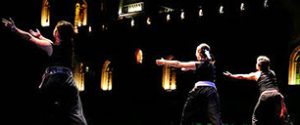 get dressed of elegance to be made a choreography with the technique and wardrobe of the contemporary dance, for 1, 2, 3, 4 or maximum 5 couples, depending on the necessity of the show. This proposal can be put in scene in a, two, three or more musical pieces.
get dressed of elegance to be made a choreography with the technique and wardrobe of the contemporary dance, for 1, 2, 3, 4 or maximum 5 couples, depending on the necessity of the show. This proposal can be put in scene in a, two, three or more musical pieces.
Other Latin American Dances
Colombia, coffee and hospital country, of the cumbia and the mapalé, of varied and rich festival folklore, where they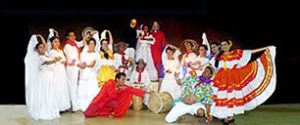 stand out several cultures: the Mestiza, as a result of the coalition Hispanic-aborigine; the Mulata located in the Atlantic and Pacific costs, as well as in the valleys interandinos and of tropical climate; It crossbreeds and Indigenous, located in the oriental plains; and, the properly this Indigenous culture whose environment is the Colombian amazonía
stand out several cultures: the Mestiza, as a result of the coalition Hispanic-aborigine; the Mulata located in the Atlantic and Pacific costs, as well as in the valleys interandinos and of tropical climate; It crossbreeds and Indigenous, located in the oriental plains; and, the properly this Indigenous culture whose environment is the Colombian amazonía
Of the oriental plains, of Tolima and the Huila we will appreciate the llaneros dances of the JOROPO SANJUANERO, the GUANEÑA of the Department of Nariño to the  south with the Ecuadorian frontier, the flavorful one and CUMBIA would originate of the costs of the Caribbean and the frantic dance of the MAPALE, the fishermen’s of the Atlantic coast erotic black rhythm and the Magdalena’s riversides.
south with the Ecuadorian frontier, the flavorful one and CUMBIA would originate of the costs of the Caribbean and the frantic dance of the MAPALE, the fishermen’s of the Atlantic coast erotic black rhythm and the Magdalena’s riversides.
Being an Andean country and of millennial cultures, Peru highlights its festival identity in the diversity of its customs and 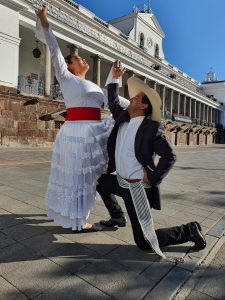 popular manifestations that overcome the three thousand, if we count among the coastal and wild, included Andean regions the afroperuanas.
popular manifestations that overcome the three thousand, if we count among the coastal and wild, included Andean regions the afroperuanas.
Their people, their landscapes and their leaning dances of a rich musical staff that it overcomes the 1.500 goods musical and great variety of native and modern instruments, make of Peru a fascinating and hospital country
Of the rich and varied Peruvian folklore, we have taken to La MARINERA  NORTEÑA whose origin would be the “moza mala” or “zamacueca”, ability dance to move in the scenario and to fall in love its couple; to the VALS CRIOLLO, mestizo rhythm that identifies the Peruvian Creole folklore and the HUAYNO of before Columbus origin, of cheerful and eminently Andean execution, to surrender tribute to their town and traditions.
NORTEÑA whose origin would be the “moza mala” or “zamacueca”, ability dance to move in the scenario and to fall in love its couple; to the VALS CRIOLLO, mestizo rhythm that identifies the Peruvian Creole folklore and the HUAYNO of before Columbus origin, of cheerful and eminently Andean execution, to surrender tribute to their town and traditions.
Venezuela is distinguished to be a country of rich traditions; its cultural manifestations are expressed according to their different regions, each one of them bill with their own dances, its music, their 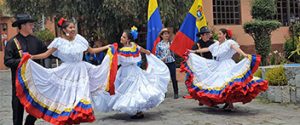 customs and its gastronomy, derived of prehispanic, Hispanic and African roots, amalgamated from the colony and transformed into a rich mestizo transculturación.
customs and its gastronomy, derived of prehispanic, Hispanic and African roots, amalgamated from the colony and transformed into a rich mestizo transculturación.
There are several rhythms that Venezuela enjoys his musical heritage, including drums, sangueos, Fuli, carousing and Calypso The Joropo however is that since the mid 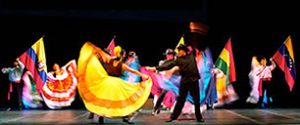 eighteenth century Venezuela sings and dances like pace of national identity.
eighteenth century Venezuela sings and dances like pace of national identity.
Depending on your region, musical instruments, figures or choreographed movements differ between joropo Plains, central and eastern tuyero and joropo.
Just a couple of dance, a harp, a cuatro and a pair of maracas to unleash the skilled movements and figures «valsiao», «escobillao» and «zapatiao», typical of the syncopated rhythm that Venezuela shares with the plains Colombians.
Here, our homage to Bolívar’s earth, to their plains, to their songs, their cultures and their people.
As fair homage to the pluriculturality of the Andean towns and without another desire of reinstating the narrow knots of fraternity that identifies us
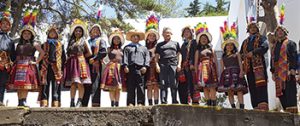
like one self inside the Andean cosmovision;
from the sister republic of Bolivia and
in desire of integrating the Andean cultures, we have recreated in a choreographic collage, the Saya of the Yungas, the Tinku of the Aymara culture, the Chacarera of the fields and a chapaca tune that identifies the rich culture of a glad town, which is recognized as Intangible Oral Patrimony for its folklore partly.
“The culture is the deep unit among that received and the spirit. This way, what arrives to the folklore is it intimately incrusted in the popular soul, that decanted, the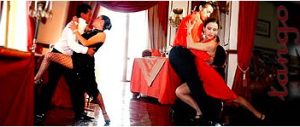 acendrado. All that which has a stamp at last, a stamp that denotes the incorporation, the typical physical physiognomy, unmistakable of each folkloric expression” it describes this way it Augusto’s thought Raúl Cortázar.
acendrado. All that which has a stamp at last, a stamp that denotes the incorporation, the typical physical physiognomy, unmistakable of each folkloric expression” it describes this way it Augusto’s thought Raúl Cortázar.
And if we speak of Raúl Cortázar, we speak of Argentina and their culture, of their dances and folklore, of the gaucho’s earth, of the muleteer, the pampas, the tango and the vidalitas.
Here it is a small sample of the cheerful 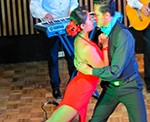 ones and colorings dances of the republic Argentina, rhythms like the CARNAVALITO DE HUMAHUACA and the infaltable CHACARERA of the northern of Salta, Jujuy, Catamarca, La Rioja and Santiago del Estero, and of course the sought-after dances of living room of the elegant TANGO and MILONGA
ones and colorings dances of the republic Argentina, rhythms like the CARNAVALITO DE HUMAHUACA and the infaltable CHACARERA of the northern of Salta, Jujuy, Catamarca, La Rioja and Santiago del Estero, and of course the sought-after dances of living room of the elegant TANGO and MILONGA

